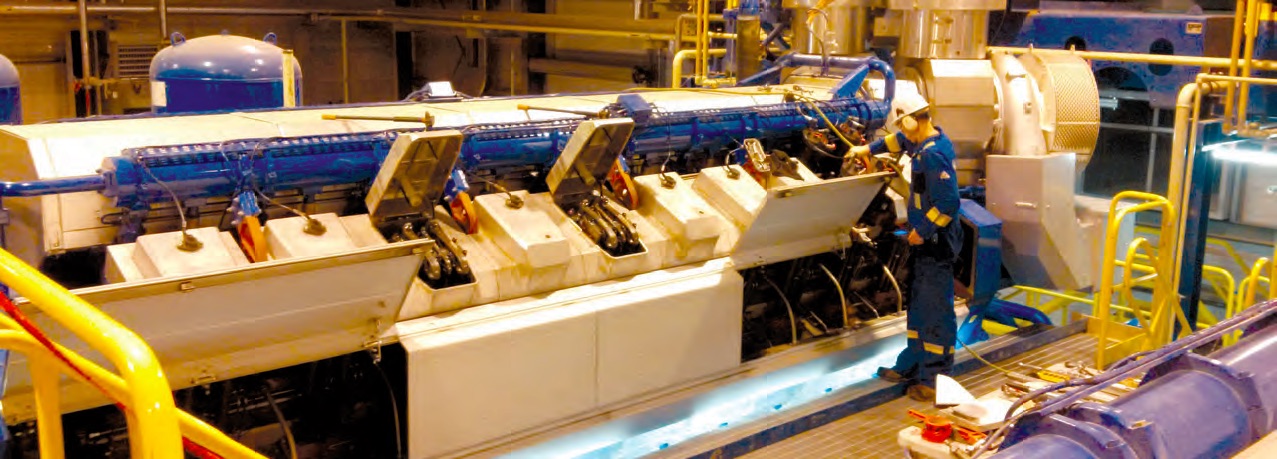Stationary gas engines
Paul Hetherington | TLT President's Report November 2020
You learn something new every day.

Stationary gas engines have definitely challenged our willingness to learn. Photo courtesy of Andy Macdaid.
One of the greatest things about the long career I have had in the lubricants industry is that each and every day is an opportunity to learn something new. I have been so lucky throughout my career to be exposed to so many different types of equipment and lubrication requirements. In those first few years, I honed my knowledge with such things as steam and gas turbo generators, huge hydrogen gas reciprocating compressors and, of course, all kinds of pumps, compressors, electric motors and gearboxes.
But the learning was far from over, as I also spent lots of time in the mining side of the business learning all about draglines, bucket wheel reclaimers, electric and hydraulic shovels, the world’s largest dump trucks and all kinds of mining support equipment. Believe it or not, all of that was just in the first half of my career at one major facility.
By moving into a consulting role and then onto my present employer, I have been exposed to all kinds of new and exciting operations and equipment. The learning just keeps coming, which, in the world of tribology and lubrication engineering, is necessary. In many ways we are a traditional bunch, we are led by the science, we don’t change things for the sake of change, and many of our lubrication fundamentals and approaches have been refined over decades. For example, we can work with a multitude of different engines and can quickly recommend the right oil for each engine and what is asked of it. But that can’t be where it stops.
In other ways, the world of lubricants is incredibly fast moving. And being open to continuous learning is what enables us to stay ahead, and to serve our customers to the best of our ability.
Stationary gas engines (SGEs) are a good example of just how quickly things can change and how important ongoing learning is. There have been a lot of engine design changes occurring recently.
More for less
The major trends in these engines are toward getting more horsepower out of similar or smaller engine sizes. Original equipment manufacturers (OEMs) are driving this with innovations such as new piston designs, Miller cycle, brake mean effective pressure increase and fuel gas flexibility. When the industry changes at this pace, it gathers momentum, attracts new participants and makes existing OEMs invest in advancing their own SGE line. While all of this is happening, those of us who are lubricant professionals see more demands on the engine oil and the need for us to keep up with the fast pace of change!
Customers always want more, of course, in terms of performance and value. So, as well as more horsepower, customers are looking to make their investment deliver, and for their machine to stay reliable longer, but not cost them more to operate. This is where we as lubrication experts come in, providing a product that allows for long engine drain intervals, to reduce downtime and those all-important operating costs.
Demands on the lubricant and advisor
What I think also is a big driver of this pace of change is the lack of standard industry specifications for SGE oils compared to what we have for passenger car and heavy-duty diesel engines. When field performance is your driver for innovation and those miniscule performance improvements that can save a ton of dollars, it gets competitive, almost personal, because there is not always a clearly defined path forward or finish line. In summary, oil manufacturers are under pressure to deliver. And so are we as lubricant professionals.
Higher efficiency engines need lubricants that can cope with harsh conditions and high temperatures, and can contribute to engine cleanliness while maintaining longer drain intervals. When you also consider changes to piston design, which in these higher power engines tends to increase oxidation, it’s easy to see why the formulation of advanced oils to suit is consequently really complex. Lubricant manufacturers are balancing detergent, antiwear, antioxidant and dispersant needs, which means a lot of potential for positive and negative interactions between components.
There is a parallel to be drawn here with us as specialists who carefully balance applying our knowledge, skills and context with being open minded to discovering and adapting.
As usual, our industry is rising to this challenge. It’s incredible how far SGE oils have come in dealing with everything that goes on in that engine, as well as controlling deposits and keeping the pistons clean. The important thing from here is staying one step ahead. As different and more challenging gas sources begin to be used, because we all know they will, we need to stay heightened to adapting and learning. We need to use the skills we have in being able to intuitively get to know a customer’s engine, read the data, listen to their experience of their machine and, in the end, we will make the right recommendation.
You know that willingness to learn I mentioned? Yikes, SGEs have definitely challenged it recently, but they are just one more step in my learning journey, and I’m still enjoying every minute of it.
Paul Hetherington is manager technical services for Petro-Canada Lubricants in Peachland, British Columbia, Canada. You can reach him at paul.hetherington@hollyfrontier.com.